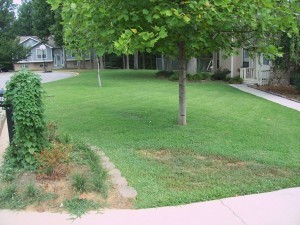- BY WP Management Team Dev
- POSTED IN Uncategorized
- WITH 0 COMMENTS
- PERMALINK
- STANDARD POST TYPE
Spring lawn maintenance is important for a healthy lawn all season. Power raking and aerating are enough to make anyone moan and groan, but neglecting maintenance and seasonal tasks can lead to bigger problems down the road. In most areas spring maintenance chores include fertilizing, applying herbicides, fertilizing, raking, and aerating.
Raking the lawn and removing the thatch is one of the most important spring chores. Thatch is part of a healthy lawn, but too much thatch can be detrimental, increasing diseases and decreasing drought tolerance by preventing roots and rhizomes from reaching the soil. Even if the lawn was raked in the fall, it’s important to remove all the grass that died over the winter. To see how much thatch has built up, spread the blades of grass apart and poke around until you hit soil. More than half an inch of thatch is considered excessive. If the thatch goes beyond the first joint to your index finger it’s time to power rake. Power rakes can be rented for about $50 a day. If you’re not comfortable operating cumbersome powered equipment, a local landscaping crew will be more than happy to do it for you.
Aerating is a yearly lawn maintenance task that increases oxygen and encourages new healthy growth. Aerating is performed by a machine that uses hollow tines to punch holes in the ground and remove plugs of soil and grass. These plugs will be chopped up in the next mowing, filtering back into the grass. The fresh soil brings micronutrients to the surface, which helps the thatch decompose. Aerating is extremely beneficial in heavy clay soils. Aeration alleviates compaction, a problem especially evident in high traffic areas where grass is stressed. Professionals can tell you how deeply to aerate for your lawn based on the type of grass and soil quality.
Get a soil test. Lawns perform best at a pH of 6.5 to 7. Soil can be naturally acidic, so it’s best to check periodically. Adding lime without testing is inefficient. Soil that is too alkaline (numbers higher than seven) is equally detrimental. At the ideal pH more nutrients are available to the growing grass. A local cooperative extension can tell you how much lime is needed per sq foot of lawn to bring the pH up to the correct level. Excessive moss can be a sign of low pH or severe compaction.
Lawn experts generally recommend fertilizing twice a year–once in spring and again in fall. If you are not performing power raking or aeration, a pre-emergent weed and feed may be applied in later winter. These pre-emergent herbicides prevent annuals like crabgrass from sprouting.
For homeowners who prefer an organic lawn maintenance program. One cubic yard of compost can be added to every 1,000 square feet of lawn. Spread evenly with a push broom. Compost will jumpstart the soil microbes for a healthier lawn. Corn gluten meal, also called CGM is an organic alternative to chemical weed and feed products. Don’t use pre-emergents if you are trying to overseed.
Overseeding the lawn is a great way to keep out the weeds. Overseeding is recommended after power raking to cover any bare spots. Depending on your climate you can choose to overseed in spring or fall. Warm season grasses are usually overseeded in spring and cool season grasses are usually planted in the fall.
Some of these tasks, like aerating, don’t need to be done every year, but it’s best to stay ahead of maintenance before things get out of hand and make the job harder to do and consequently less likely to get done. Although power raking and aerating seem very traumatic they are extremely beneficial for a healthy lawn in the long run. Try these tips for a healthier greener lawn all season long.

